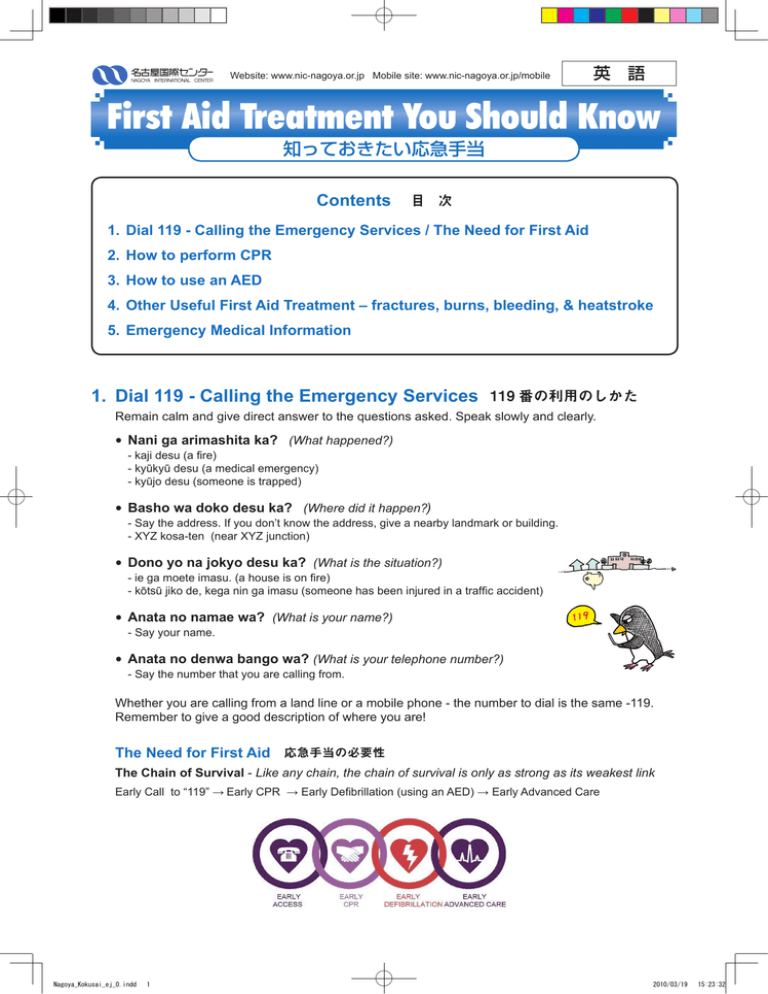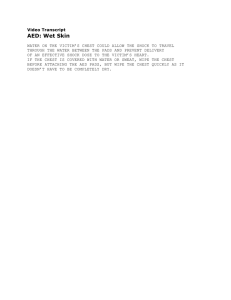First Aid Treatment You Should Know
advertisement

Website: www.nic-nagoya.or.jp Mobile site: www.nic-nagoya.or.jp/mobile 英 語 First Aid Treatment You Should Know 知っておきたい応急手当 Contents 目 次 1. Dial 119 - Calling the Emergency Services / The Need for First Aid 2. How to perform CPR 3. How to use an AED 4. Other Useful First Aid Treatment – fractures, burns, bleeding, & heatstroke 5. Emergency Medical Information 1. Dial 119 - Calling the Emergency Services 119 番の利用のしかた Remain calm and give direct answer to the questions asked. Speak slowly and clearly. ● Nani ga arimashita ka? (What happened?) - kaji desu (a fire) - kyūkyū desu (a medical emergency) - kyūjo desu (someone is trapped) ● Basho wa doko desu ka? (Where did it happen?) - Say the address. If you don’t know the address, give a nearby landmark or building. - XYZ kosa-ten (near XYZ junction) ● Dono yo na jokyo desu ka? (What is the situation?) - ie ga moete imasu. (a house is on fire) - kōtsū jiko de, kega nin ga imasu (someone has been injured in a traffic accident) ● Anata no namae wa? (What is your name?) - Say your name. ● Anata no denwa bango wa? (What is your telephone number?) - Say the number that you are calling from. Whether you are calling from a land line or a mobile phone - the number to dial is the same -119. Remember to give a good description of where you are! The Need for First Aid 応急手当の必要性 The Chain of Survival - Like any chain, the chain of survival is only as strong as its weakest link Early Call to “119” → Early CPR → Early Defibrillation (using an AED) → Early Advanced Care Nagoya_Kokusai_ej_0.indd 1 2010/03/19 15:23:32 2. CPR (for adults and children over 8 years of age) 心肺蘇生法(成人、8 歳以上) 1) Check for Response 反応の確認 - determine responsiveness of the patient by tapping on the patient’s shoulders and shouting in both ears. 2) Call for Assistance 助けを求める - if no response ask someone nearby to call for an ambulance (119). 3) Check Airway 気道の確保 - perform a head tilt, chin lift to open airway. 4) Check for Breathing 呼吸の確認 - Place your ear over nose and mouth and look down the chest. Listen and feel for any air movement on your cheek for about 10 seconds. - If the patient is breathing place them in the recovery position and wait for paramedics. If they are not breathing start artificial respiration. 5) Artificial Respiration 人工呼吸 - Pinch the patient’s nose with your thumb and forefinger. - Put your mouth around that of the patient’s and give 2 slow breaths (about a second each) just enough to see chest rise. Note: To reduce the risk of infection between you and the patient, the use of a CPR mouthpiece is highly recommended. 6) Chest Compression 胸骨圧迫 - Place the heel of your hand in the center of the chest between the nipple line. Place your other hand on top of the first and keep your elbows locked. - Compress the patient’s chest hard and fast; do not pause. - Repeat compression and breathing at a rate of 100 compressions per minute. Do not stop until relieved. 7) Chest Compression & Artificial Breathing 胸骨圧迫と人工呼吸 - Give 2 breaths for every 30 compressions. Continue this rhythm until paramedics arrive and take over. Nagoya_Kokusai_ej_0.indd 2 2010/03/19 15:23:35 3. How to use an AED AED の使い方・注意点 In order to safely use an AED (Automated External Defibrillator) you must follow the AED’s audio guidance. Do NOT use an AED on a child under 1 year of age. 1) Turn on the AED 電源を入れる - Turn on the power and follow the audio guidance. 2) Attach Pads 電源パッドの装着 - Expose the patient’s chest – this will allow the pads to send a better electrical shock. - Make sure any items that may cause injury are removed: ・Use a towel (or similar item) to wipe off any sweat of water from the patient’s chest. ・Remove any medical patches. ・If the patient is wearing a pacemaker, place pads at least 3cm away from it. ・Remove any jewellery or other metallic objects. 3) Electrocardiograph Analysis 心電図の解析をする - After attaching the pads to the patient, attach the wires to the AED unit. - Follow the audio guidance, and move away from the patient; make sure nobody is touching the patient. 4) The Electric Shock 除細動の実施 - The AED will determine whether an electric shock is required and will automatically charge up. - If the AED instructs you to push the shock button, once again make sure nobody is touching the patient before pushing the button. 5) After the Electric Shock 除細動の実施後 If after the shock the AED informs you that another shock is not required, start CPR again as soon as possible. 4. Other Useful First Aid Treatment その他の応急手当 1) Fractures 骨折 ●Symptoms - intense pain, deformity, sudden swelling, change in skin colour. ●Treatment - Even if the symptoms of fracture are slight, make sure the affected area is immobilized. - Immobilize the damaged bone (minimize movement) - Do not straighten the broken bone; even if the bone is deformed immobilize as it is. < Using a brace > < Using a triangular bandage > 2) Burns やけど ●Treatment - As soon as possible place the affected area under cool/tepid (not cold) running water. - If at all possible avoid touching the burn blister. - After cooling the affected area cover it with a sanitary gauze. - After applying first aid seek professional medical care. Nagoya_Kokusai_ej_0.indd 3 2010/03/19 15:23:37 3) Bleeding 止血方法 A reduction of the blood volume from internal or external bleeding can cause circulation problems and lead to circulatory shock. If blood loss further continues it can lead to death. ●Treatment - Direct pressure on the wound – in the majority of cases this method is effective. Pushing down on the wound with a “thick”, folded , hand towel (or similar item) is effective. - If the body losses more than 20% of its blood in a short period of time, circulatory shock may occur. Raising a patient’s legs can improve blood supply to the heart. Note: When treating someone who is bleeding in order to lessen the risk of infection take precautions so that you do not come in direct contact with the blood. 4) Heatstroke 熱中症 Heatstroke can affect anyone and is usually a result of excessively high outside temperatures or physical exertion. ●Symptoms - include headaches, tiredness, nausea and vomiting, and in some cases unconsciousness. ●Treatment - The normal action to take is to rest, cool, and re-hydrate the sufferer. If the symptoms do not improve or become worse seek immediate medical assistance. 5. Emergency Medical Information 緊急医療情報 ○ The Aichi Emergency Treatment Information Center 愛知県救急医療情報センター A 24-hour service that provides information about where to go for medical treatment in Aichi Prefecture, in the event of a traffic accident, sudden illness, and other emergencies. You can find information about medical facilities on-line in Japanese, English, and other languages. Website: www.qq.pref.aichi.jp ○ Voice & Fax Information System in 5 Languages 外国語音声 FAX 案内 An automatic voice & fax information system is available in 5 languages providing information about local medical facilities. English Fax 052-249-9799 Chinese Fax 052-249-9499 French Fax 052-249-9899 ○ Tel: 052-263-1133 Spanish Fax 052-249-9699 Portuguese Fax 052-249-3299 Emergency Medical Consultations for Children 子ども救急相談 If your child becomes ill after normal hospital hours (for example at night or at the weekend), a medical professional can advice you over the phone on what action to take depending upon the child’s symptoms. ○Shoni Kyukyu Telephone Consultations 小児救急電話相談 Available: 19:00 - 23:00 on weekends, holidays, and at New Year Tel: 052-263-9909 ○Kodomo Anshin Telephone Consultations 子どもあんしん電話相談 Tel: 052-933-1174 Available: Weekdays (20:00 ∼ 24:00), weekends, holidays, and at New Year (18:00 ∼ 24:00) ○ Nagoya International Center Information Counter 名古屋国際センター 情報カウンター The Nagoya International Center provides vital information in 8 languages. Available: Open 09:00 - 19:00; closed Mondays & New Year Tel: 052-581-0100 NIC’s Three-way Telephone Consultation System Tel: 052-581-6112 - Consult with a civic service (such as a health center) over the phone via an interpreter. Nagoya_Kokusai_ej_0.indd 4 2010/03/19 15:23:38
